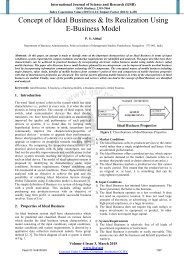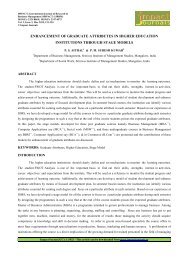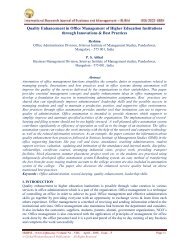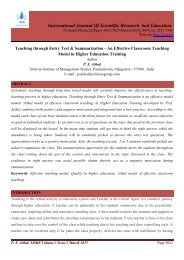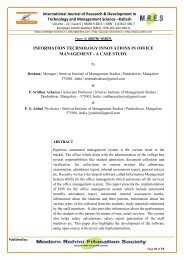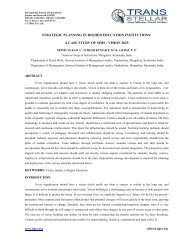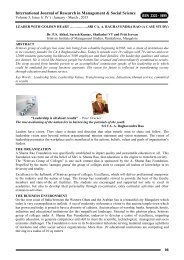How Innovations and Best Practices can Transform Higher Education Institutions : A case study of SIMS
Education has become competitive so as the educational institutions. In order to survive the competition, institutions have to improve the quality of their services. Changes in culture, aspiration and levels of skills required in securing employment for students, force higher education institutions today to rework on their educational models and add value to each and every aspect of their service. Innovations and best practices serve to enhance quality and add value. Srinivas Institute of Management Studies (SIMS), which combines technology, management and social service education has identified and implemented innovations and best practices to differentiate itself among the competitors and to add value in its educational services. In this paper, we have discussed innovations, small and big, develped indigineously and implemented during last four years. They are broadly classified under six key aspects namely "curricular aspects, teaching-learning and evaluation, research, consultancy and extension, infrastructure and learning resources, student support and progression, and governance, leadership, and management". The paper also contains some of the intitutional and individual faculty best practices having visible impact on the quality of higher education imparted by the institution. The best practices concern admission, fees, attendance, teaching, performance, skill building, employability, student involvement, collective learning, value addition, ensuring transparency, information dessimination etc. Finally two institutional best practices are elaborated with its aim of practice, underlying principles and concepts, particular contextual features or challenging issues that have had to be addressed in designing and implementing the practice, and its implementation, including its uniqueness in Indian higher education, evidence of success, identifying the problems encountered and resources required to implement the practice.
Education has become competitive so as the educational institutions. In order to survive the competition, institutions have to improve the quality of their services. Changes in culture, aspiration
and levels of skills required in securing employment for students, force higher education institutions
today to rework on their educational models and add value to each and every aspect of their service. Innovations and best practices serve to enhance quality and add value. Srinivas Institute of
Management Studies (SIMS), which combines technology, management and social service education
has identified and implemented innovations and best practices to differentiate itself among the competitors and to add value in its educational services. In this paper, we have discussed
innovations, small and big, develped indigineously and implemented during last four years. They are
broadly classified under six key aspects namely "curricular aspects, teaching-learning and evaluation, research, consultancy and extension, infrastructure and learning resources, student support and progression, and governance, leadership, and management". The paper also contains some of the
intitutional and individual faculty best practices having visible impact on the quality of higher education imparted by the institution. The best practices concern admission, fees, attendance, teaching, performance, skill building, employability, student involvement, collective learning, value
addition, ensuring transparency, information dessimination etc. Finally two institutional best practices are elaborated with its aim of practice, underlying principles and concepts, particular contextual features or challenging issues that have had to be addressed in designing and implementing the practice, and its implementation, including its uniqueness in Indian higher
education, evidence of success, identifying the problems encountered and resources required to implement the practice.
You also want an ePaper? Increase the reach of your titles
YUMPU automatically turns print PDFs into web optimized ePapers that Google loves.
International Journal <strong>of</strong> Management (IJM), ISSN 0976 – 6502(Print), ISSN 0976 - 6510(Online),<br />
Volume 6, Issue 2, February (2015), pp. 83-98 © IAEME<br />
2. Goal<br />
In order to maintain the quality <strong>of</strong> teaching learning process at desired level, it is essential<br />
that the performance <strong>of</strong> the faculty is monitored on a regular basis. Since any assessment to be done<br />
alone by a superior has its own drawbacks, it is appropriate that each faculty being assessed should<br />
be given an opportunity for self-assessment on the same parameters. Even this is not sufficient<br />
because, the recipient or beneficiaries namely students are not getting an opportunity to assess their<br />
teachers, With this in view the college has adopted a comprehensive Performance Management<br />
System which gives scope for all the three components to be put together under one evaluation.<br />
3. The Context<br />
In the context <strong>of</strong> higher education, the quality <strong>of</strong> the faculty is a determinant for the<br />
effectiveness <strong>of</strong> teaching - learning, student development <strong>and</strong> institution building. It is therefore<br />
essential that the faculty maintain high quality capable <strong>of</strong> imparting the best required to the students.<br />
These for example, include improving the teaching style, use <strong>of</strong> varying teaching techniques, <strong>and</strong><br />
involving students in the learning process. A true evaluations <strong>of</strong> the faculty helps in improving their<br />
capability through knowledge generation, involvement in research <strong>and</strong> consultancy, personality<br />
development <strong>and</strong> the contribution to the society. All the more, in the present time, it is important<br />
that a good teacher admired by the students who receive his services. In the light <strong>of</strong> this the faculty<br />
should strive to continuously improve while performing on the job in areas like research,<br />
consultancy, higher studies, technology adoption, <strong>and</strong> community service. He should foresee the<br />
challenges ahead <strong>and</strong> prepare himself for long term sustainability in the pr<strong>of</strong>ession.<br />
4. The Practice<br />
Our model <strong>of</strong> faculty performance management is built on a overall grade point <strong>of</strong> 250 points<br />
which is subdivided into six areas <strong>of</strong> evaluation as shown below:<br />
(1) Academic activities: This carries the highest score <strong>of</strong> 100 points. This include, Course Material<br />
Development, Planning & Scheduling classes, academic record keeping, knowledge <strong>and</strong> comm<strong>and</strong><br />
<strong>of</strong> the subject, assignments <strong>and</strong> tutorials, administered to the students, presentation <strong>and</strong><br />
communication skills, better evaluation practices, event management <strong>and</strong> student development<br />
activities, commitment to work ethics, <strong>and</strong> creativity <strong>and</strong> innovation in teaching learning process.<br />
(2) Contribution to Institutional Activities: This carries 40 points under various performance criteria<br />
such as co-ordination <strong>of</strong> academic activities, student support systems, institutional support systems,<br />
<strong>and</strong> new initiatives for team involvement.<br />
(3) Research, Publications <strong>and</strong> Consultancies: This carries a total <strong>of</strong> 25 grade points which is subdivided<br />
into contributions to research <strong>and</strong> publications including Guidance to Students Projects,<br />
efforts made for obtaining funded projects. participation in sponsored projects, preparations <strong>and</strong><br />
review <strong>of</strong> research papers, presentation in conferences <strong>and</strong> workshop <strong>and</strong> publications in journals.<br />
(4) Pr<strong>of</strong>essional activities & Self development Initiatives: This carries a total <strong>of</strong> 25 points under<br />
various performance criteria including initiatives for acquiring higher qualifications, recognition in<br />
pr<strong>of</strong>essional societies, expert lectures delivered, chairing technical sessions, honours received, <strong>and</strong><br />
such other recognition <strong>and</strong> achievement.<br />
(5) Participation in student admission: This carries a total <strong>of</strong> 10 points under various performance<br />
criteria like involvement in admission <strong>of</strong> students, propag<strong>and</strong>a <strong>and</strong> publicity for enhancing<br />
admission, utilizing opportunity to spread the information <strong>of</strong> the courses <strong>and</strong> admissions to the<br />
college in various forms <strong>and</strong> networking through alumni for enhancing admission.<br />
(6) Student assessment: This is a most important part <strong>of</strong> the assessment since, this has to be done by<br />
the students in a spirit <strong>of</strong> judicious review <strong>and</strong> confidentiality. The factors considered here are<br />
regularity, punctuality, time consciousness, preparation for classes, competency in the subject,<br />
syllabus completion in time, presentation skill (voice, clarity & language), methodology adopted in<br />
93




